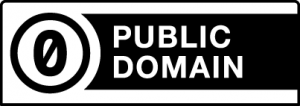21 Public Domain Tools and Differences from the CC Licenses
Public Domain
In addition to the CC license suite, Creative Commons also has an option for creators who want to take a “no rights reserved” approach and disclaim copyright entirely. The CC0 (Open) also works on three layers: the human-readable deed, the lawyer-readable legal code, and the machine-readable metadata. Some countries do not allow creators to dedicate their work to the public domain through a waiver or abandonment of those rights, so CC0 includes a “fall back” license that allows anyone in the world to do anything with the work unconditionally.

Public domain tools
In addition to the CC license suite, CC also has two public domain tools represented by the icons below. Like the licenses, CC0 is a copyright tool, but it also covers a few additional rights beyond those covered by the CC licenses, such as non competition laws. From a reuse perspective, there still may be other rights that require clearance separately, such as trademark and patent rights, and third party rights in the work, such as publicity or privacy rights.
These public domain tools are not equivalent to licenses:

CC0 enables creators to dedicate their works to the worldwide public domain to the greatest extent possible. Note that some jurisdictions do not allow creators to dedicate their works to the public domain, so CC0 has other legal mechanisms included to help deal with this situation where it applies. You might also see this tool being used by museums, libraries or archives. This doesn’t mean they are claiming copyright over those works, but rather they are waiving all possible rights they might have in other jurisdictions to the reproductions of those works.

The Public Domain Mark is a label used to mark works known to be free of all copyright restrictions. Unlike CC0, the Public Domain Mark has no legal effect when applied to a work. It serves only as a label to inform the public about the public domain status of a work and is often used by museums, libraries and archives working with very old works.
May I apply a Creative Commons license to a work in the public domain?
CC licenses should not be applied to works in the worldwide public domain. All CC licenses are clear that they do not have the effect of placing restrictions on material that would otherwise be unrestricted, and you cannot remove a work from the public domain by applying a CC license to it. If you want to dedicate your own work to the public domain before the expiration of applicable copyright or similar rights, use CC’s legally robust public domain dedication . If a work is already in the worldwide public domain, you should mark it with CC’s Public Domain Mark.
